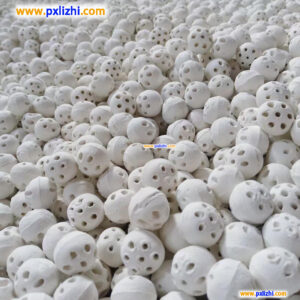
markdown
# Inert Ceramic Balls: Ultimate Guide to Applications, Benefits, and Selection Criteria
## **What Are Inert Ceramic Balls?**
Inert ceramic balls are high-purity, non-reactive spherical materials engineered for industrial applications requiring chemical stability and thermal resistance. Composed primarily of alumina, silica, and zirconia, these balls serve as essential components in chemical reactors, distillation columns, and catalytic processes. Their inert nature ensures zero chemical interaction with processed materials, making them ideal for protecting sensitive catalysts and optimizing fluid dynamics.
**Key Characteristics:**
– Exceptional thermal shock resistance
– High mechanical strength and hardness
– Chemical inertness across pH ranges
– Uniform size distribution (typically 3mm-50mm diameters)
—
## **Industrial Applications and Use Cases**
### **Catalyst Bed Support Media**
Inert ceramic balls create stable foundation layers in catalytic reactors, preventing catalyst migration while maintaining optimal gas/liquid distribution. They’re crucial in petroleum refining, petrochemical processing, and environmental emission control systems.
### **Distillation and Absorption Towers**
These balls function as random packing materials in separation columns, enhancing vapor-liquid contact efficiency. Their spherical shape minimizes pressure drop while maximizing surface area for mass transfer operations.
### **Filter Media and Contamination Prevention**
Used as filtering agents, inert ceramic balls trap particulates and impurities in fluid streams. Their smooth surface prevents fouling and simplifies cleaning procedures in water treatment and pharmaceutical manufacturing.
—
## **Performance Benefits and Advantages**
**Enhanced Process Efficiency**
– Reduce pressure drops by up to 40% compared to irregular packing
– Maintain structural integrity at temperatures exceeding 1600°C
– Extend catalyst lifespan through proper distribution and protection
**Economic and Operational Benefits**
– Lower energy consumption due to improved flow dynamics
– Reduced maintenance frequency and downtime
– Long-term cost savings through durable, reusable materials
**Safety and Environmental Impact**
– Non-toxic composition meets FDA and EPA standards
– Recyclable materials support sustainable operations
– Fire-resistant properties enhance workplace safety
—
## **Selection Criteria for Optimal Performance**
### **Material Composition Considerations**
Select alumina content based on operating temperature:
– 90-95% Alumina: Standard chemical processes (≤1400°C)
– 99% Alumina: High-temperature applications (≤1600°C)
– Zirconia-stabilized: Thermal cycling environments
### **Size and Configuration Factors**
– Match ball diameter to vessel dimensions and catalyst size
– Standard sizes: 1/4″ (6mm) for laboratory units, 1″ (25mm) for industrial reactors
– Custom sizes available for specialized equipment
### **Quality Verification Standards**
– ISO 9001 certified manufacturing
– Crush strength testing documentation
– Chemical composition analysis reports
– Size consistency verification (≤±5% diameter variation)
—
## **Frequently Asked Questions**
**Q: How do inert ceramic balls differ from active catalysts?**
A: Unlike catalysts that promote chemical reactions, inert ceramic balls are chemically inactive and serve physical roles in supporting, distributing, and protecting active materials within processing systems.
**Q: Can ceramic balls be reused after contamination?**
A: Yes, most industrial-grade balls withstand multiple cleaning cycles using chemical washing or thermal regeneration. Always consult manufacturer guidelines for specific contamination scenarios.
**Q: What’s the typical lifespan in continuous operation?**
A: With proper selection and operating conditions, high-quality inert ceramic ball products typically last 3-7 years before requiring replacement, depending on thermal cycling frequency and chemical exposure.
—
## **Optimize Your Process Today**
Ready to enhance your operational efficiency? Our technical specialists can help you select the perfect inert ceramic ball configuration for your specific application. [Contact our engineering team] for free product samples and customized technical recommendations.
**Download our comprehensive specification guide** to compare material properties, size options, and
